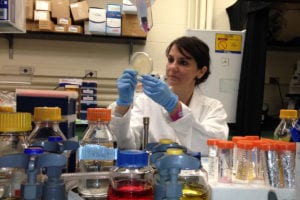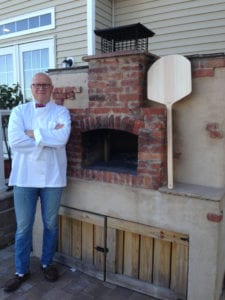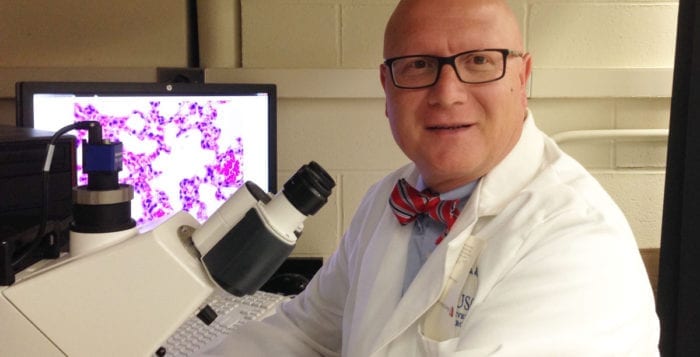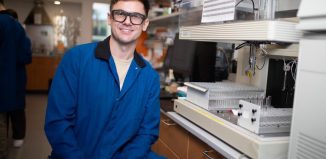Antifungal work lands SBU professor $6 million from NIH
Like the fictional Steve Austin, Stony Brook University’s Maurizio Del Poeta has become the ““Six Million Dollar Man.”
No, Del Poeta didn’t crash in an experimental spacecraft; and no, he doesn’t have bionic limbs. Instead, work with a potentially deadly fungus in his laboratory helped Del Poeta, a professor in the Department of Molecular Genetics & Microbiology at Stony Brook University, earn two, multiyear $3 million grants from the National Institutes of Health.
Del Poeta is attacking a fungus that can be deadly, particularly for people with weakened immune systems. Recently, his approach yielded an unexpected result that may lead to a vaccine. “We were looking for a gene that would metabolize a fungal sphingolipid on the surface of the fungus,” he said.
The gene he mutated caused a different function than expected, leading mice with exposure to this strain to become resistant to fungal infection, Del Poeta said.
This change may be the key to providing a vaccination against Cryptococcus neoformans, a fungus present in numerous places, including in bird droppings.

“We think that this discovery will open the road to a new vaccination strategy against fungi” including candidiasis caused by Candida albicans or aspergillosis, caused by Aspergillus funigatus, Del Poeta said.
The same gene for sterol glucosidase that Del Poeta and the researchers in his lab mutated is also found in the genome of these other fungal species. “One could potentially make a vaccine containing the three fungal mutants combined and inject them together to protect simultaneously” against all three species, he said. These three infections account for over 1.3 million deaths per year, according to the Centers for Disease Control and Prevention.
This vaccine could prove effective for immunocompetent and immunocompromised individuals. A potential vaccine is particularly important for the latter group.
Del Poeta and his colleagues injected the mutated version of the fungus into an animal model that mirrored the conditions of a patient with the human immunodeficiency virus. The vaccine “protected 100 percent” against an infection, Del Poeta said. “Whatever this mutant is doing, the protection is not determined by the presence of CD4 cells.”
CD4 cells are a type of white blood cell that fights infection. They are at the center of vaccines that train the immune system to recognize and destroy live versions of infections. Without those cells, vaccination becomes more difficult, but, clearly, not impossible.
His results earned him a 1 score, the top mark from reviewers, from the National Institutes of Health, which recently awarded him a $3 million grant to study this mutated fungus. The grant should become active on July 1.
John Perfect, the James B. Duke Professor of Medicine and chief of the Division of Infections Disease at Duke University, brought Del Poeta into his laboratory from Italy. He is proud of his protege, describing Del Poeta in an email as a “major investigator in fungal pathogenesis.”
An important question Del Poeta can’t answer is how this attenuated strain conveys resistance.
Before this promising early work can become a part of preventive treatment, Del Poeta said he and his team will look for a different formulation of this potential vaccine.
“It will be difficult to convince the FDA to administer a live fungus to an immunocompromised patient, even if the fungus will be attenuated,” he explained. “So, we need to make a better vaccine.”
His postdoctoral researcher, Antonella Rella, who is the first author on a paper published in Frontiers in Microbiology describing their results, is making and testing new formulations. She has already found promising results using only certain portions of the cell, Del Poeta said.

Del Poeta is also working in drug development. He received a $3 million grant this past December from the NIH for his continued work on drugs to treat fungal infections.
Last June, Del Poeta published a study in mBio, the online journal of the American Society for Microbiology, in which he found two compounds, BHBM and its derivative DO, that decreased the level of a lipid fungal cells need to reproduce.
Since then, he has found that some derivatives are more potent and less toxic.
He has teamed up with Iwao Ojima, the director of the Institute of Chemical Biology and Drug Discovery at Stony Brook University, and John Mallamo, who was a director in drug discovery at Cephalon. The scientific team is working with Brian McCarthy, an entrepreneur-in-residence, as a part of a new company called MicroRid Technologies.
The first milestone in the next three to four years is to raise additional funds for FDA filing and to perform a Phase 1 clinical trial some time between 2018 and 2020.
Del Poeta “exudes optimism” and his “scientific rigor and thoughts are simply first rate,” said Perfect.
When he’s not working to stop potentially deadly fungal infections, Del Poeta lives in Mount Sinai with his wife Chiara Luberto, who is studying leukemia at the Cancer Center at Stony Brook, and his sons Matteo, who is 9, and Francesco, who is 6.
Originally from Treia, Italy, which is near Florence on the Adriatic coast, Del Poeta worked in a pizzeria when he was younger. He built a brick oven in his backyard, where he hosts neighbors and the families of his sons’ classmates. His favorite pizza, called Amir Pizza after a former talented postdoctoral student in his lab, is a white pizza with extra-thin-sliced white onions, one thin-sliced hard avocado, a generous portion of pistachios and mozzarella.
While the work Del Poeta does has clinical implications, he has no expectations to move to a biotechnology company. “I love what I do,” he said. “If I can make the life of a patient a little better, if I can bring a new drug to the clinic or even contribute a little bit to improve the survival of a patient, I would be so grateful.”
Readers who would like to know more about the battle against fungal infections can gather information at the Global Action Fund for Fungal Infections web site, www.gaffi.org.







